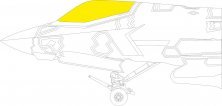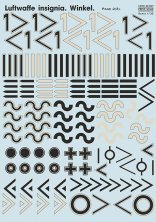
1/144 Raf Waddington, Lincolnshire, United Kingdom, 1960s
- Etat du stock:Disponible en 2-4 semaines
- Code produit:KWB144511
- Marque:Kits-World
Description
Kits-World - 1/144 Raf Waddington, Lincolnshire, United Kingdom, 1960s. 225mm(W) x 225mm(H) 9inches(W) x 9inches(H)
RAF Waddington began as a training base for the Royal Flying Corps in 1916. Between this time and 1919, the station was home to a number of squadrons both under RFC, and later, Raf control. Nos. 82, 97, 105, 117 and 123 Squadrons Rfc between 1917 and 1918, and Nos. 23, 203 and 204 Squadrons Raf throughout 1919 were based at Waddington.
Following the Great War, Waddington was closed to allow extensive refurbishment and upgrade to a bomber base, opening again in March 1937. The first squadron to be based at the station was No. 50 Squadron equipped with the Hawker Hind light bomber and then upgrading to Handley Page Hampden's. Two weeks later, No. 110 Squadron arrived, again flying hinds which were replaced shortly afterwards with Bristol Blenheim's. In June 1937, the Hawker Hind-equipped No. 88 Squadron was reformed at Waddington but relocated to Raf Boscombe Down, Wiltshire, the following month. Also in June, Waddington saw the arrival of No. 44 Squadron, moving from Raf Andover, Hampshire, with their Bristol Blenheim's. No. 44 Squadron switched to the Avro Anson and Handley Page Hampden in 1939. 1939 saw the departure of No. 110 Squadron for Raf Wattisham, Suffolk.
At the outbreak of the Second World War, Nos. 44 and 50 Squadrons immediately began operations against German targets at Kiel and during the battle of Britain, undertook offensive actions against German barge concentrations in the build up to Operation Sea Lion (Seelowe), the planned German invasion of the United Kingdom. No. 50 Squadron move to Raf Lindholme, South Yorkshire, later in 1940.
In 1941, No. 44 Squadron was renamed No. 44 (Rhodesia) Squadron and replaced its Hampden's with the new Avro Lancaster, becoming the first Raf Bomber Command unit to operate the type, their first operational mission being on March 2, 1942. In April of that year, No. 44 Squadron, along with No. 97 from nearby Raf Coningsby, took part in Operation Margin against the Man U-boat engine plants at Augsburg. No. 44 Squadron left Waddington for Raf Dunholme Lodge, Lincolnshire, in May 1943.
The Second World War also saw a number of other units based at Waddington, which operated from the base to a lesser of greater degree. As follows:
No. 142 Squadron was located briefly at Waddington between June and July 1940 with Fairey Battle's, relocating to Raf Binbrook, Lincolnshire. No. 9 Squadron arrived in August 1942 with Vickers Wellington III's, before switching to Lancaster I and III's and moving to Raf Bardney, Lincolnshire in April 1943. No. 207 Squadron was reformed at Waddington with the unsuccessful Avro Manchester, and additionally later, the Handley Page Hampden. The unit moved to Raf Bottesford, Leicestershire in November 1941. No. 420 (Canadian) Squadron was formed in December 1941 with Hampden's, moving to Raf Skipton-on Swale, North Yorkshire in August 1942. No. 463 (Australian) Squadron was formed in November 1943 with Lancaster I and III's and moved to Raf Skellingthorpe, Lincoln in July 1945. No. 467 (Australian) Squadron operated from Waddington during the period November 1943 to June 1945 flying Lancaster I's and III's before moving to Raf Metheringham, Lincolnshire. No. 617 Dambusters Squadron briefly operated from the station between June 1945 and January 1946 before relocating to Raf Digri, Pakistan.
RAF Waddington was a major player in the run up to, and during the Cold War. In 1957, No. 83 Squadron became the first Raf unit to be equipped with the Avro Vulcan B.1. Receiving its first aircraft in March 1957, it became fully operational in May before moving to Raf Scampton, Lincolnshire in August 1960. Other units based at Waddington through the Cold War era are as follows:
No. 9 Squadron Squadron flying Vulcan B.2's operated from Waddington between 1975 and 1982 before disbandment and reformation at Raf Honington as the RAF's first operational Panavia Tornado GR.1 operator. Between July and September 1946, No. 12 Squadron was briefly stationed at Waddington with Lancaster I and III's, relocating to Raf Binbrook and re-equipping with Avro Lincoln B.2's. No. 21 Squadron was based at the station between May 1955 and December 1957 with English Electric Canberra B.2. No. 27 Squadron the same. No. 44 Squadron was reformed at Waddington in 1960 and operated the Vulcan B.1 and B.2 from there until December 1982 when they were disbanded. No. 50 Squadron operated Lincoln B.2's between January 1946 and 1951 before being disbanded. The squadron was reformed at Waddington in August 1962 with Vulcan B.1's and later B.2/B.2K's. They were disbanded in March 1984. No. 57 Squadron operated Lincoln B.2's from Waddington from October 1946 to April 1951, leaving for Raf Marham, Norfolk shortly afterwards. In June 1951 the unit returned to Waddington equipped with the Boeing Washington B.I, leaving for Raf Coningsby in April 1952. No. 61 Squadron flew Lancaster B.I's and B.III's from January 1946, replacing these shortly afterward with the Lincoln B.2 and moving to Raf Wittering, Cambridgeshire in August 1953. No. 101 Squadron arrived from Raf Finningley, South Yorkshire in June 1961 with Vulcan B.1 and B.2's, staying at Waddington until they were disbanded in August 1982.
The 1982 Falklands War saw three Vulcan B.2's (XM597, XM598, and XM607) from Nos. 44, 50 and 101 Squadrons take part in Operation Black Buck raids against Port Stanley Airport in the Falkland Islands. The three Vulcans, specifically chosen because they were fitted with more powerful Bristol Olympus 301 engines, transited down to Raf Ascension Island from Waddington, then flying on from Ascension for the missions. There were seven missions altogether, each code numbered according to date carried out and mission. A forth Vulcan, XM612, was held in reserve. Air-to-air refuelling via Handley Page Victor K.2 tankers was used. Even today, the effects of the Black Buck raids are open to debate on their overall effectiveness or logistical cost. At the time, they were the longest bombing raids by range in history.
The USAF also used Waddington at various points through the later 1970's and into the early 1990's with A-7D's and K's of the Iowa, Ohio and South Dakota Air National Guards visiting or deploying there briefly during this time period.
July 1991 saw Waddington become home to No. 8 Squadron, which relocated from Raf Lossiemouth and trading its ageing Avro Shackleton AEW.2's with the Boeing AEW.1 Sentry airborne early warning platform. The Sentry's were withdrawn in August 2021, with the Squadron planning to redeploy in 2023 from Raf Lossiemouth with the Boeing E-7 Wedgetail (to be designated Wedgetail AEW.1).
As of 2021, Waddington is still the home to a number of units including Nos. 13 and 39 Squadrons operating the General Atomics MQ-9 Reaper, No. 14 Squadron operating the Beechcraft Shadow R.1 and No. 51 Squadron operating the Boeing RC-135W Rivet Joint reconnaissance platform. The base is also home to a number of non-flying units and organisations including the Lincolnshire and Nottinghamshire Air Ambulance.
The section which this Kits-World base depicts is part of a larger area of hard standings linking onto the main runway, each with a Vulcan on Qra (Quick Reaction Alert) standby in case of nuclear attack. Depicted as it was during the 1960's, this area no longer exists, but is based on existing photographs from the time.
Main aircraft operated for the period (1960's):
Avro Vulcan B.1 or B.2. Shown is a Vulcan B.2 of No. 50 Squadron.
GPS- 53º10'31.65' N 0º30'59.46' W











